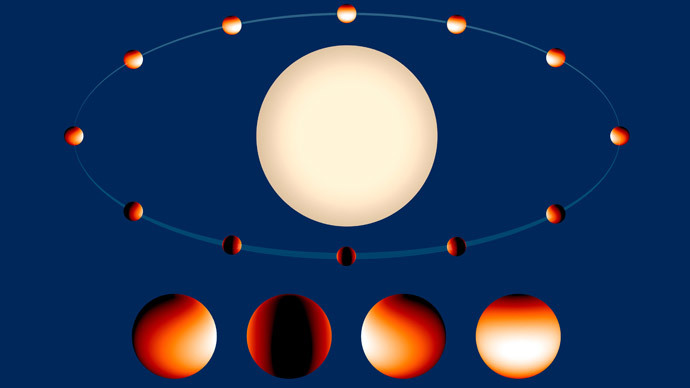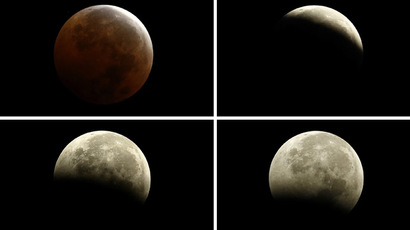'Steel-melting temperature, wind speed of sound': Extreme exoplanet awes astronomers

Despite temperatures that can melt steel and winds the speed of sound, an extreme exoplanet located 260 light years from Earth has vaporized water in its atmosphere, according to the most detailed-ever weather map created by the Hubble Telescope.
Astronomers combined two methods of analyzing exoplanets to create a temperature map of the Jupiter-size Wasp-43b alien planet, which by all definitions turned out to be a place where nothing is done by halves. The study by a dozen researchers from different universities and research institutions, led by astronomer Kevin Stevenson of the University of Chicago, was published in the journalScience.
Wasp-43b, first discovered in 2011, is extremely close to its orange dwarf host star – which it always faces on one side in a phenomenon known as “tidal locking” – and completes an orbit in just 19 hours.
“The blink of an eye compared to the 365 days it takes Earth to orbit the sun,” study co-author Jean-Michel Désert, of the University of Colorado Boulder, said.
It is a mystery how Wasp-43b got so close to its parent star, although the abundance of water vapor suggests it formed in an orbit close to that of Jupiter in our own solar system. But in case of our Jupiter, little is known about the amount of water it has, as it is locked away as ice.
“These observations allow us to determine the abundance of water in the planet’s atmosphere, which is a major element involved in planetary formation,” the co-author of the project, Jean-Michel Desert, of the University of Colorado, said in a statement. “Basically it is like taking a planet like Jupiter into a giant laboratory, then warming it at such a high temperature that all of the atoms and molecules comprising its atmosphere are in a gas phase.”
Wasp-43b is a lifeless world of extremes with temperatures soaring to 3,000 degrees Fahrenheit on the dayside of the planet and plunging to 1,000 degrees Fahrenheit on the dark one. There are no oceans or continents on Wasp-43b, which is just a hot ball of gas, mostly hydrogen. Only the severe temperature difference allowed astronomers to remotely observe the passage of heat between day and night sides.
Scientists managed to get an idea of the inhospitable world of the exoplanet by measuring temperatures at different layers of the planet’s atmosphere, and were thus able to trace the amount and distribution of water vapor.
The astronomers carried out three days of observations with the Hubble Telescope. As there is no planet anything like the Wasp-43b in our solar system, the research provided a unique opportunity for scientists to get a better knowledge of planetary physics and how such planets are formed.
At 260 light tears from Earth, Wasp-43b is too far away to be photographed, but astronomers were able to observe regular dips in the light of its parent star as the seething planet passed in front of it.
“Our observations are the first of their kind in terms of providing a two-dimensional map of the exoplanet’s thermal structure,” Stevenson said. “These maps can be used to constrain circulation models that predict how heat is transported from an exoplanet’s hot day side to its cool night side.”
Astronomers used a technique known as spectroscopy, where they divided the planet’s light into its component colors. This allowed them to determine the temperatures in the atmosphere and the amount of water in it. And by scrutinizing the planet’s rotation they could also see how water was distributed at different longitudes.
“These measurements have opened the door for new kinds of ways to compare the properties of different types of planets. The big picture is by making these precise measurements of thermal structure and abundance of chemical species [in the atmosphere], it becomes useful to do comparative studies amongst the planets outside our solar system,” a co-author of the research, Jacob Bean of the University of Chicago, told Space.com.
The scientists said that their research will be useful one day when instruments exist to look for water vapor and other signs of life in smaller planets the size of Earth.














